Stand up paddle boarding (SUP) offers something for everyone. You can head out for a relaxing paddle on a calm lake or catch waves in the ocean. Or maybe you'd like to do SUP yoga or go for a fast-paced paddle to get a workout. Whatever your ambitions, having the right board is key to your enjoyment. In this buying guide, we'll review the main points you need to think about when choosing a board.
To find the right stand up paddle board for you, consider how you're going to use it, how it will fit your body and how you want it to handle in the water. The key decision points will be the shape of the board, getting the correct volume and capacity, as well as the proper length, width and thickness. Whether you choose a solid or inflatable board will largely depend on how you will transport it and how much storage space you have. From there, you'll consider a board's fins and any extras or accessories that work for you.
Video: How to Choose a Stand Up Paddle Board
SUP Hull Types
The hull, or body, of a paddle board plays a major role in determining how the board performs in the water. Most SUPs have either a planing hull or a displacement hull. There are a handful with a hybrid design that combine the best attributes of each design.
Either hull shape can be enjoyed by beginner paddlers, but there are differences that make them better for some activities than others. Because of this, it's wise to choose the hull type based on how you plan to use your board.
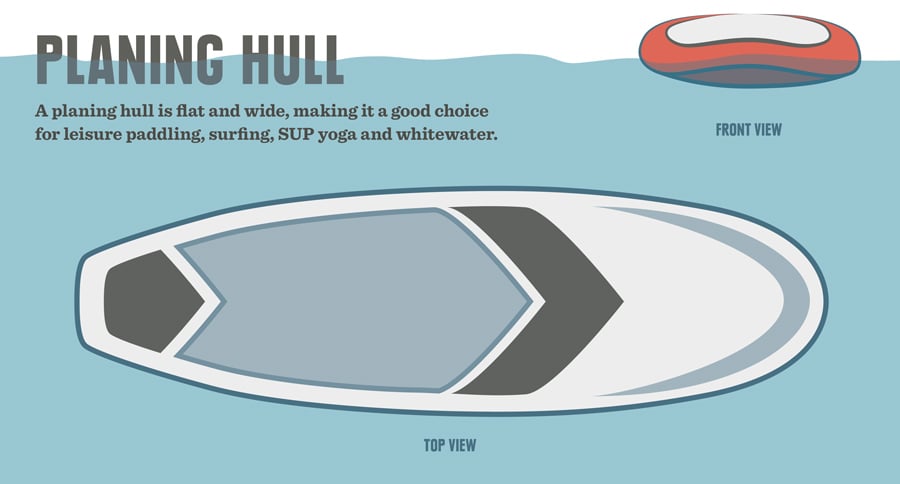
Planing Hull
A planing hull is flat and wide, similar to a surfboard. It is designed to ride on top of the water and be very maneuverable. Boards with planing hulls are a good choice for leisure paddling, surfing, SUP yoga and whitewater.
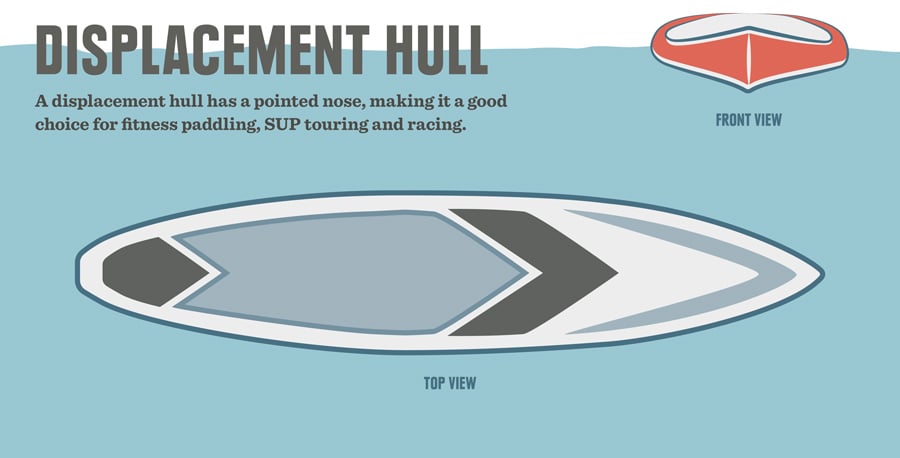
Displacement Hull
SUPs with displacement hulls have a pointed nose or bow (front end) similar to that of a kayak or canoe. The hull slices through water, pushing the water around the nose to the sides of the SUP to improve efficiency and create a fast, smooth ride. The efficiency of a displacement hull requires less effort than a planing hull to paddle, allowing you to go longer distances at faster speeds. They also track nice and straight but are generally a bit less maneuverable than planing hulls.
Paddlers choose displacement hulls for a variety of applications, but always with an eye toward paddling efficiency and speed. Some applications include fitness paddling, SUP touring/camping and racing.
Solid vs. Inflatable SUPs
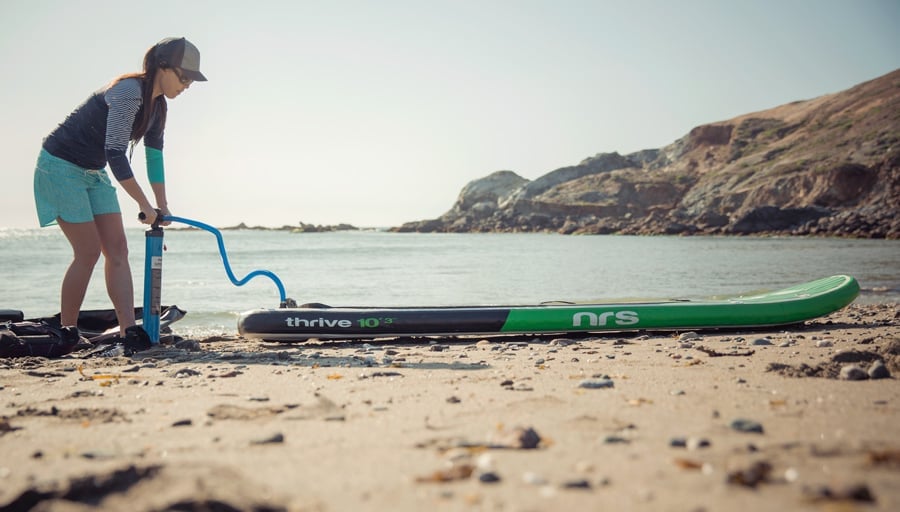
Planing hull and displacement hull SUPs are available in two different general construction styles: solid or inflatable.
Solid SUPs
Most solid boards have an EPS foam core that's wrapped with fiberglass and epoxy. This is a fairly lightweight, durable and affordable construction. Carbon fiber is a lighter and stiffer option, but it's also more expensive. Plastic SUPs are more affordable, but they are very heavy and lack the performance of other materials. Some SUPs incorporate lightweight wood for a beautiful appearance.
Why get a solid SUP:
- Performance is your priority: Solid boards offer the best performance on the water. They travel faster, smoother and with less effort than an inflatable. If paddling fast and far are your priorities, a solid SUP is for you.
- For a perfect fit: Solid SUPs are available in a larger variety of sizes and finely tuned shapes than inflatable SUPs, so you're more likely to find one that fits you just right.
- Stability is important: A solid board is a tad more rigid than an inflatable board, which can provide a more stable feel, especially when riding waves. Solid boards also tend to ride lower in the water, which can also create a more stable feel.
- You have a place to store it: Solid SUPs can take up a lot of space. If you have ample room in your garage and a vehicle that can transport it, then a solid SUP is a fine choice.
Inflatable SUPs
Inflatable SUPs feature PVC exteriors with drop-stitch construction that create an air core. They come with a pump for inflating the board and a storage bag for when it's not in use. A quality inflatable SUP is designed to be inflated to 12-15 pounds per square inch and should feel very rigid when fully inflated.
Why get an inflatable SUP:
- You have limited storage space: If you live in a small house, condo or apartment, you may not have room for a large solid board. Inflatable SUPs are compact when deflated and can easily be stowed in small spaces, like a closet or the trunk of a car.
- You're traveling: If you're taking a road trip or hopping on a plane, you can bring along your inflatable SUP and do some paddling when you reach your destination. Packed away in its storage bag, an inflatable can be checked on an airplane or stowed in a train, bus or car. Most storage bags have backpack straps for easy carrying.
- You're hiking to a lake: If you're headed to an alpine lake and want to paddle, you certainly cannot carry a solid board. An inflatable stowed in its storage bag is still heavy, but it's pretty much your only option.
- You're paddling whitewater: Like a raft or inflatable kayak, an inflatable SUP is better suited to handle bumps up against rocks and logs than a solid board.
- You like SUP yoga: You don't have to get an inflatable for SUP yoga, but they tend to be a bit softer than solid boards, making them more comfortable for yoga poses.
SUP Volume and Weight Capacity

A SUP board must work for your size. If the board doesn't displace the correct amount of water for your weight, you won't be supported well and the board may feel unstable. Board volume and weight capacity are two factors that affect how stable you will feel and how well the board will travel through the water.
Volume and weight capacity are determined by the length, width and thickness of the board. SUP manufacturers combine these three dimensions in different ways to achieve different performance characteristics (see the SUP Length, SUP Width and SUP Thickness sections of this article to learn more).
Volume: A paddle board's volume, expressed in liters, gives an indication of the board's ability to float with weight on it. The higher the volume, the more weight the board can support. You can find volume for a SUP listed in the specs on REI.com.
Weight capacity: Each paddle board has a rider weight capacity, which is listed in pounds in the specs on REI.com. Knowing weight capacity is important because if you're too heavy for a board, it will ride lower in the water and be inefficient to paddle. When thinking about weight capacity, consider the total amount of weight you will put on the board, including your body weight and the weight of any gear, food and drinking water that you'll be taking with you.
Volume and weight capacity as it relates to hull type: Most planing-hull boards are very forgiving, so as long as you're below the weight capacity, the board will perform well for you. However, with displacement-hull SUPs, volume and weight capacity are more significant. SUP makers spend a lot of time determining the most efficient position for displacement boards to be in the water. If you overweight a displacement board and cause it to sink too low, it will drag and feel slow. If you're too light for a board, you won't sink it enough and the board will feel heavy and difficult to control.
SUP Length
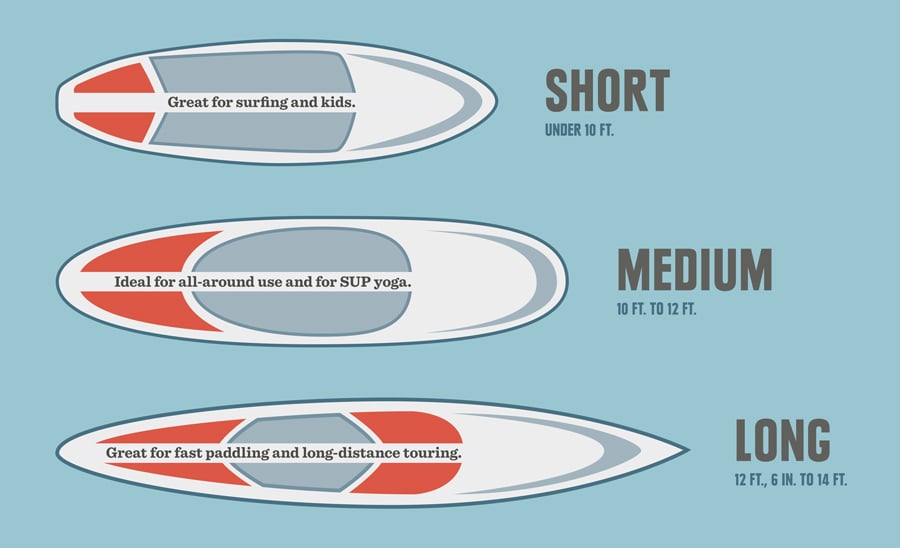
The length of a board plays a major role in determining how the board handles. In general, longer boards are faster than shorter boards, but shorter boards are more maneuverable. Keep in mind your intended use when deciding what length SUP to buy:
- Short boards (under 10') are great for surfing and/or kids. These boards almost always have a planing hull. Short boards are more maneuverable than long boards, making them great for surfing waves. Boards designed specifically for kids are typically around 8' long.
- Medium boards (10' to 12') are ideal for all-around use and for SUP yoga. Most of these boards have planing hulls, but sometime you'll find a displacement-hull SUP at this length.
- Long boards (12'6" and above) are great for fast paddling and long-distance touring. The majority of boards in this size range are displacement-hull SUPs. They're faster than short and medium boards and they tend to track straighter. If you're interested in paddling fast or touring long distances, you'll want a long board.
When choosing a length, it's helpful to understand how it relates to volume and weight capacity. A longer board can increase the volume and capacity, which can make it feel more stable and allow you to carry more on the board (width and thickness are also factors in volume and capacity; see the SUP Width and SUP Thickness sections of this article).
Consider, too, board length in regards to your type of car, home storage situation and length of walk to the beach or shore (longer boards are more difficult to carry, especially in windy places).
SUP Width

Width is another important factor that affects how the board handles. A wider board will always be more stable than a skinny board, but keep in mind that a wide board can be slower and, if the board is too wide for you, difficult to paddle. SUPs are made in widths ranging from about 25 inches up to 36 inches to accommodate a variety of needs.
When choosing how wide your SUP should be, think about the type of paddling you do, your body type and ability level:
- Type of paddling: If you're going on long tours that require you to carry extra gear, like a cooler of food and a tent, choose a wider board in order to have more storage space. The same is true if you're doing SUP yoga; a board that is 31 inches wide or more will give you space and stability for doing poses. Narrower boards, on the other hand, are faster and more maneuverable, making them the choice among racers and surfers.
- Body type: Try to match the width of the SUP to your body type. In general, if you're a small person, go with a narrower board and if you're a big person, go with a wider board. This is because a smaller person can generally find their balance on a narrow board, whereas a bigger person may struggle to do so. Also, if you put a smaller person on a board that is too big for them, they have to awkwardly reach out to the side to get their paddle in the water, resulting in an inefficient stroke.
- Ability level: If you've paddled a lot, you may be comfortable on a narrower, faster SUP. However, someone brand new to SUP, might prefer a little extra width to help them feel more secure.
As with length, width affects the overall volume and weight capacity, so you can select a width with this in mind. For example, if you've determined the length you want based on the type of paddling you want to do, you can choose a width (and/or thickness; see the SUP Thickness section of this article) that gives you the appropriate board volume and weight capacity.
SUP Thickness

After finding a board with the length and width that makes the most sense for you and your paddling style, consider a third factor: board thickness.
The main reason to consider the thickness of a stand up paddle board is because of how it affects the overall volume and weight capacity. If you're looking at two boards of the same length and width but different thicknesses, the thicker board has more volume than the thinner one and the higher the volume, the more weight it can support.
Here's how you might use thickness: You've determined you want a long, skinny displacement board for cruising fast on flatwater. If you're a small person, choosing a thin board will keep the overall volume of the board lower so that you're properly weighting the board for the most efficient performance.
SUP Fins
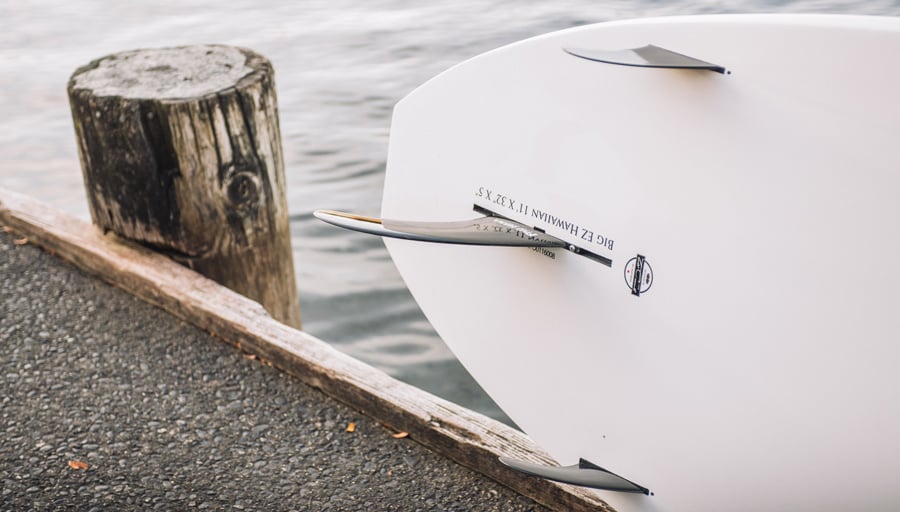
Fins add tracking and stability to a paddle board. In general, larger fins with wider bases and longer front edges will track straighter and provide more stability than smaller fins. On the other hand, a smaller fin provides better maneuverability. Most fins are removable, so you can swap out fins and take them off for storage.
There are many different options for how fins are configured on the bottom of your SUP. Some popular SUP fin configurations include:
Single fin: Many SUPs include a single fin placed in a finbox and secured with a nut and screw. The finbox has a channel for the fin to slide back and forth in. The single fin provides good tracking and minimal drag, making it a good choice for flatwater paddling.
3-fin setup: Also called a thruster, this setup promotes straight tracking on flatwater and offers good control in surf. All three fins are usually about the same size.
2+1 setup: This configuration includes a larger center fin with a smaller fin on each side of it. This is a common setup on SUPs designed for surfing.
Fins for inflatable SUPs: Inflatable SUPs can have any of the fin configurations already listed. What sets them apart is that they feature either flexible rubber fins attached to the board or detachable semi-rigid fins.
SUP Extras and Accessories

Depending on how you plan to use your SUP, you might want to look for a board with extra features, such as:
- Bungee straps/tie-down: Sometimes located on the front and/or rear of the board, these stretchy straps or tie-down spots are great for securing dry bags, clothing and coolers.
- Attachment points/mounts: Some boards have specific attachment points for fishing-rod holders, seats, cameras and more. These accessories are typically sold separately.
After purchasing a SUP, you need just a few more key pieces of equipment to enjoy paddle boarding. These include:
- Paddle: A SUP paddle looks a bit like a stretched-out canoe paddle with a tear-drop-shaped blade that angles forward for maximum paddling efficiency. The correct length paddle will reach up to your wrist when you stand the paddle up in front of you and raise your arm above your head. Read more about choosing and sizing paddles in our article, SUP Paddles: How to Choose.
- PFD (Personal Flotation Device): The U.S. Coast Guard classifies stand up paddle boards as vessels (when used outside the narrow limits of swimming or surfing areas), so it is required that you wear a PFD. Learn how to choose the right PFD for you in our article, PFDs: How to Choose. Note that the regulations also require you to always carry a safety whistle and have a light available if you are paddling after sunset.
- Proper clothing: For cool conditions where hypothermia is a concern, wear a wetsuit or dry suit. In milder conditions, wear shorts and a T-shirt or bathing suit—something that moves with you and can get wet and dries quickly.
- Leash: Typically sold separately, a leash tethers your SUP to you, keeping it close by if you fall off. Your SUP is a large flotation device, so being attached to it can be important for your safety. There are leashes designed specifically for surf, flatwater and rivers; be sure to purchase the correct one for your intended use.
- Car rack: Unless you have an inflatable SUP, you need a way to transport your board on your vehicle. There are specific SUP racks designed to go on the crossbars of your roof rack, or you can use padding, such as foam blocks, and utility straps to secure the board to the roof of your vehicle.




